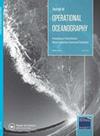马克兰俯冲带海啸的数值模拟——以1945年事件为例
IF 2.4
3区 地球科学
Q4 METEOROLOGY & ATMOSPHERIC SCIENCES
引用次数: 6
摘要
海啸会造成重大的生命损失和财产、生态系统以及海洋结构和设施的破坏。海啸模拟的结果用于推导沿海和海洋结构和设施的稳健设计条件。这些结果还用于应急规划和决策,以估计可能造成的生命损失、财产和海洋设施的损害,并制定救援和减灾措施,规划清理行动。Royal HaskoningDHV (RHDHV)建立了一个覆盖北阿拉伯海的区域潮汐水动力模型,为解决上述问题提供数据。1945年发生在马克兰俯冲带的地震引发了沿伊朗和巴基斯坦海岸线的海啸,造成多达4000人死亡。此外,海啸对财产和其他沿海设施造成了灾难性的破坏。本研究中的海啸模拟是针对1945年的这次事件进行的。使用DHI的MIKE21流动模型FM模拟了这次海啸事件,本文给出了模拟的样本结果以作说明。还讨论了结构设计考虑因素和减少海啸风险的措施。该模型可用于模拟阿拉伯海内产生的任何海啸。本文中描述的模拟1945年马克兰俯冲带海啸的方法也可以应用于模拟世界其他地区的这类事件。本文章由计算机程序翻译,如有差异,请以英文原文为准。
Numerical modelling of tsunami in the Makran Subduction Zone – A case study on the 1945 event
ABSTRACT Tsunamis cause significant loss of life and damage to properties, ecosystems and marine structures and facilities. Tsunami modelling results are used for deriving robust design conditions for coastal and marine structures and facilities. The results are also used for emergency planning and decision-making to estimate the potential loss of life, damage to properties and marine facilities and to develop rescue and mitigation measures and plan clean-up operations. Royal HaskoningDHV (RHDHV) has set up a regional tidal hydrodynamic model covering the Northern Arabian Sea to provide data to address the above issues. The 1945 earthquake in the Makran Subduction Zone generated a tsunami along the coastlines of Iran and Pakistan killing as many as 4,000 people. Furthermore, the tsunami caused catastrophic damage to properties and other coastal facilities. The tsunami modelling in the present study was carried out for this 1945 event. The MIKE21 Flow Model FM of DHI was used to simulate this tsunami event and sample results from the modelling are presented in this paper for illustration purposes. Structural design considerations and tsunami risk reduction measures are also discussed. The model could be used to simulate any tsunami generated within the Arabian Sea. The methodology described in this paper for modelling the 1945 tsunami in the Makran Subduction Zone could also be applied to simulate this type of events at other sites around the world.
求助全文
通过发布文献求助,成功后即可免费获取论文全文。
去求助
来源期刊
CiteScore
7.50
自引率
9.70%
发文量
8
审稿时长
>12 weeks
期刊介绍:
The Journal of Operational Oceanography will publish papers which examine the role of oceanography in contributing to the fields of: Numerical Weather Prediction; Development of Climatologies; Implications of Ocean Change; Ocean and Climate Forecasting; Ocean Observing Technologies; Eutrophication; Climate Assessment; Shoreline Change; Marine and Sea State Prediction; Model Development and Validation; Coastal Flooding; Reducing Public Health Risks; Short-Range Ocean Forecasting; Forces on Structures; Ocean Policy; Protecting and Restoring Ecosystem health; Controlling and Mitigating Natural Hazards; Safe and Efficient Marine Operations

 求助内容:
求助内容: 应助结果提醒方式:
应助结果提醒方式:


